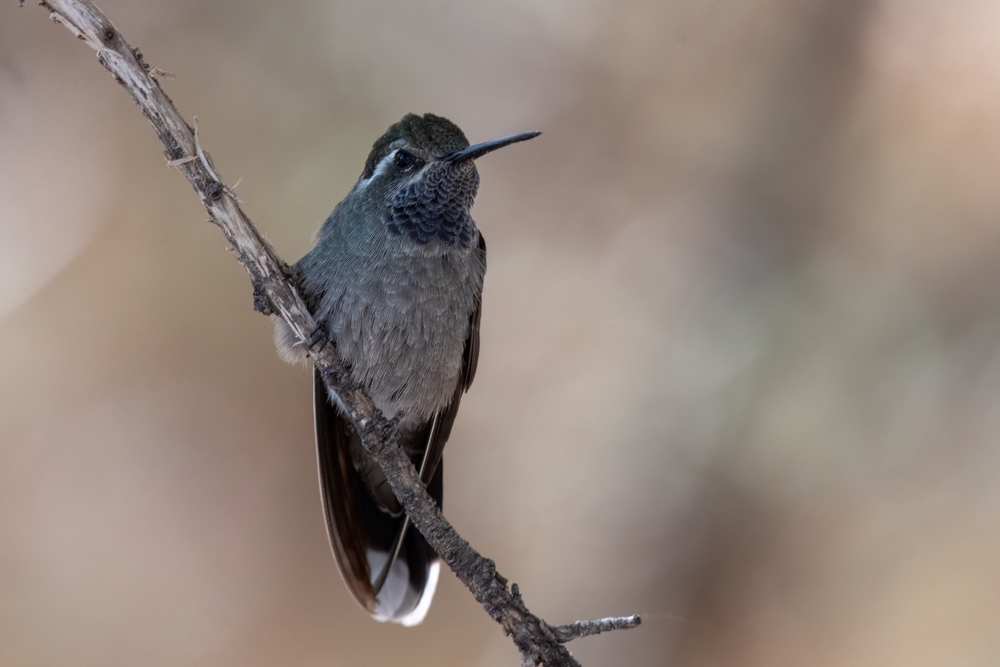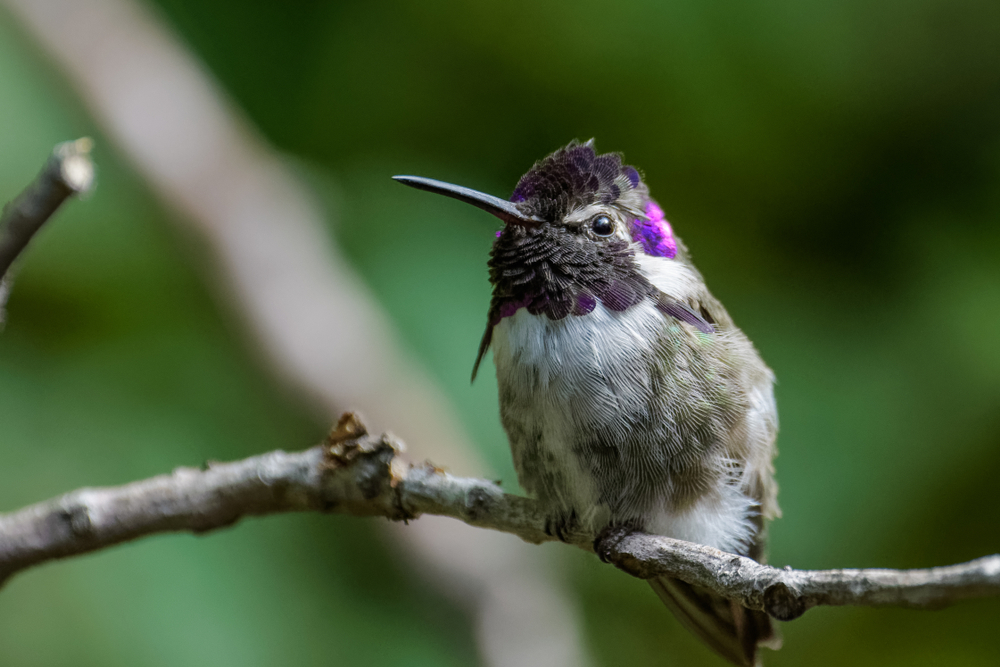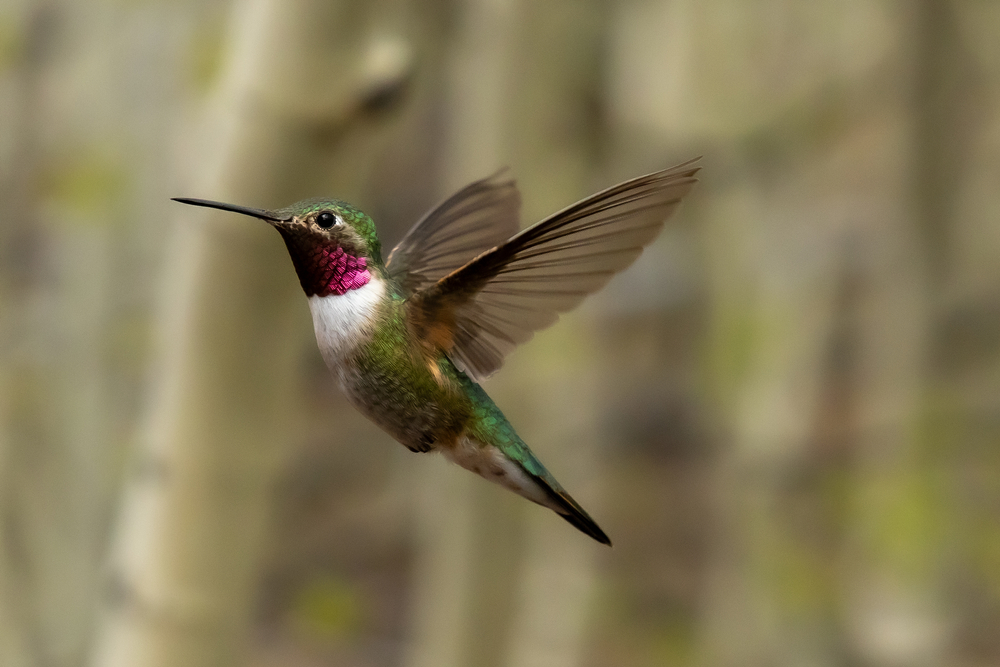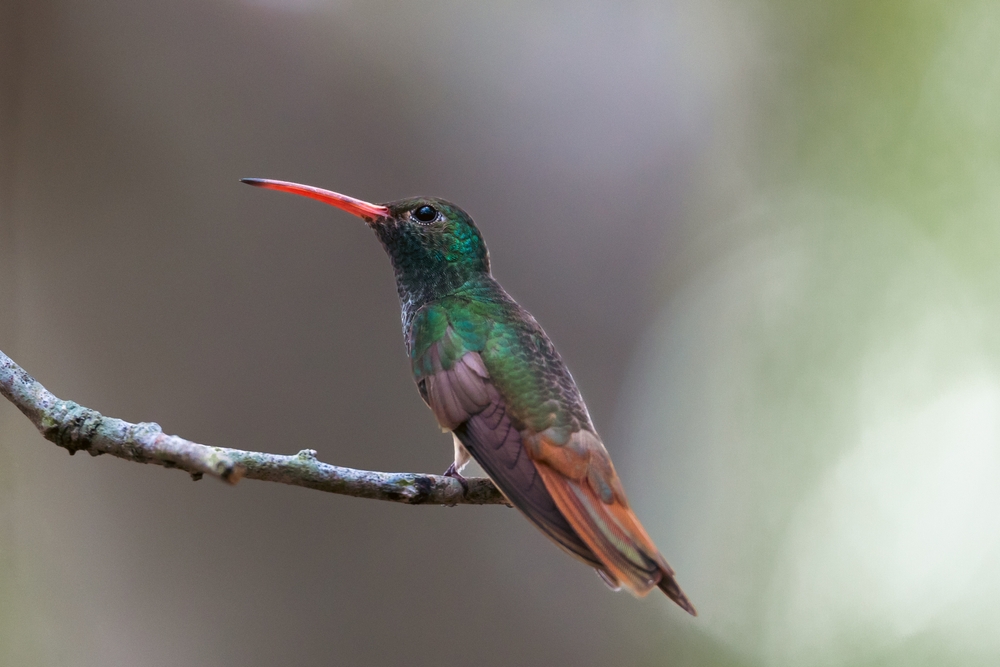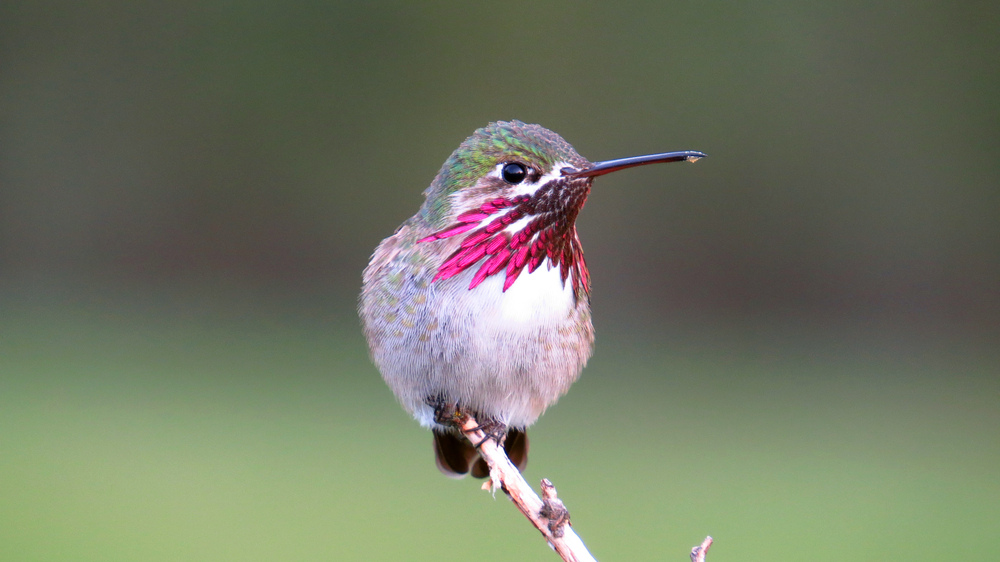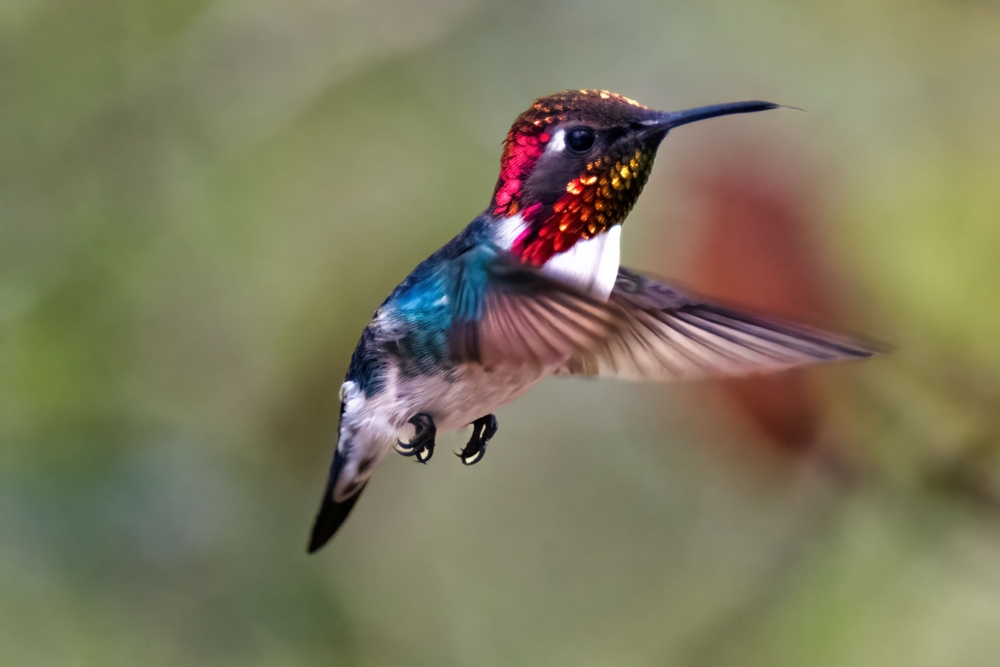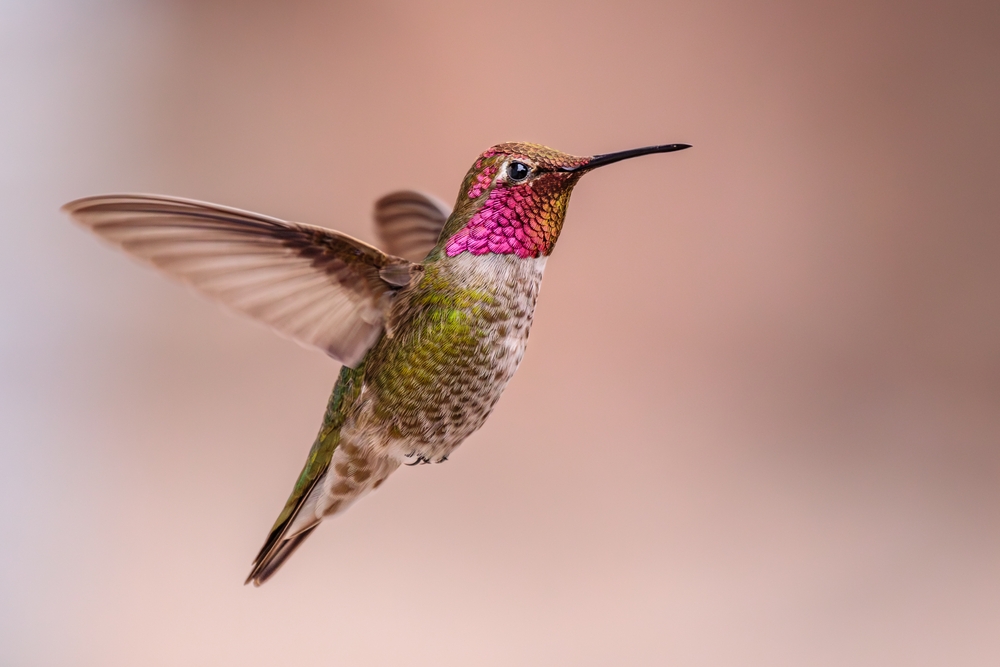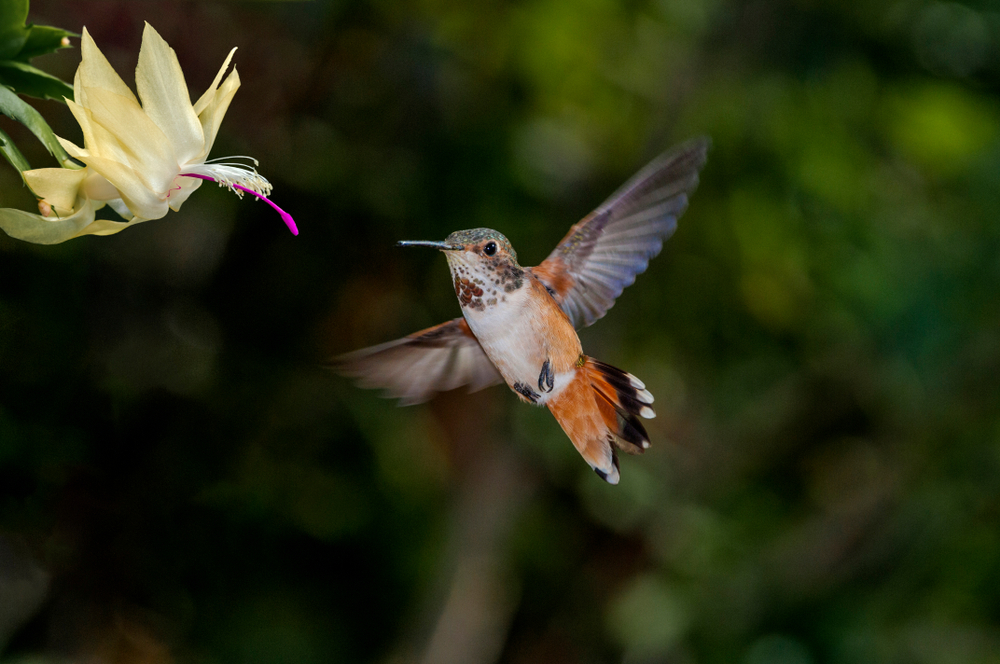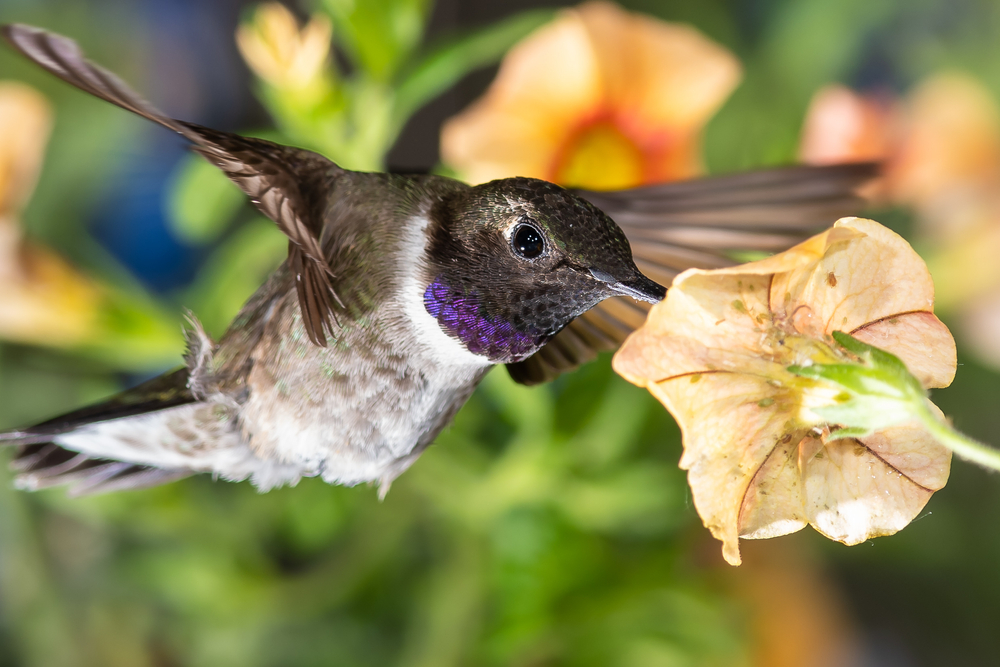The Crowned Woodnymph (Thalurania colombica) is closely related to other hummingbirds in the Thalurania genus, particularly the Fork-tailed Woodnymph (Thalurania furcata), which is similar in appearance but differs in range and plumage details.
About
The Crowned Woodnymph (Thalurania colombica) is a brilliantly colored hummingbird of the family Trochilidae, native to the tropical forests of Central and South America. Its range extends from Honduras and Nicaragua through Costa Rica and Panama into Colombia, Ecuador, and Venezuela. This species thrives in humid lowland and foothill forests, forest edges, and shaded plantations, where it dazzles observers with its jewel-like plumage and rapid, darting movements.
Medium in size for a hummingbird, the Crowned Woodnymph measures about 9.5–12 cm (3.7–4.7 in) in length and weighs 4–5 grams. Males are unmistakable, adorned with an iridescent violet crown, throat, and chest that shimmer in sunlight, contrasting with their glittering emerald-green back and belly. The wings and tail are dark, adding to the dramatic effect. Females are less flamboyant, displaying green upperparts with grayish underparts washed with green, and a slightly forked tail tipped in white.
The Crowned Woodnymph feeds primarily on nectar from a wide range of tropical flowers, often favoring brightly colored blooms with tubular shapes. It supplements its diet with insects and spiders, providing vital protein. Known for its agility, it hovers while feeding and frequently visits the same flowers, acting as an important pollinator in its ecosystems. Males are territorial and aggressively defend nectar-rich feeding sites from rivals.
Breeding habits vary by region, but females are solely responsible for nest building and chick rearing. Nests are tiny, cup-shaped structures crafted from plant down, moss, and spider silk, usually attached to branches in sheltered locations. The female lays two pea-sized eggs and tends the young until they fledge.
Though widespread and generally common, the Crowned Woodnymph depends on intact tropical forests. Deforestation and habitat degradation remain concerns, but it continues to be one of the most dazzling and frequently seen hummingbirds in its range.
Physical Characteristics
Plumage:
The Crowned Woodnymph (Thalurania colombica) is a medium-sized hummingbird known for its dazzling, jewel-like plumage with strong sexual dimorphism.
-
Male: Sparkling emerald-green crown, back, and breast, with a violet-blue throat and belly that shine brightly in sunlight. The wings are dark purple, and the deeply forked tail is glittering blue-violet.
-
Female: Much plainer, with green upperparts, grayish-white underparts, and a notched green tail with white tips.
Head:
The male’s crown glows metallic green, contrasting with the violet-blue throat. The bill is slender, straight, and black, well-suited for feeding on tubular flowers.
Body:
Compact and sleek, with strong iridescence in males that shifts dramatically with light angles. Females are more camouflaged, aiding in nesting and chick protection.
Size:
-
Length: 3.5–4.3 in (9–11 cm)
-
Wingspan: About 4.7–5.1 in (12–13 cm)
-
Weight: 0.15–0.2 oz (4.5–5.5 g)
Feet & Tail:
Feet are tiny, adapted mainly for perching. The tail is long and deeply forked in males, while females have a shorter, less dramatic tail with white-tipped feathers.
Flight Style:
Wingbeats average around 50–60 per second, allowing precise hovering and rapid darting flight between flowers. Males are often aggressive, defending nectar-rich feeding areas.
The Crowned Woodnymph’s shimmering emerald crown, violet-blue underparts, and forked tail in males make it one of the most spectacular and unmistakable hummingbirds of Central and South American forests.
Reproduction
Breeding Season:
The Crowned Woodnymph breeds primarily during the rainy season, which varies by region but often falls between March and July in Central America and Colombia, when flowers and insects are most abundant.
Courtship:
-
Males defend small feeding territories and perch conspicuously, flashing their iridescent emerald crown and violet-blue underparts to attract females.
-
Displays include hovering flights around females, wing whirring, and chasing intruders from nectar sources.
-
As with most hummingbirds, males do not assist with nesting or raising chicks once mating is complete.
Nesting:
-
The female alone builds the nest, usually 3–10 ft (1–3 m) above ground in shrubs or low tree branches.
-
The nest is tiny and cup-shaped, constructed from plant down, moss, and spider silk, camouflaged with lichens and bark flakes.
-
Spider silk allows the nest to stretch as chicks grow.
Eggs:
-
A typical clutch contains 2 tiny white eggs, each about the size of a pea (0.5 in / 1.3 cm long).
Incubation:
-
Lasts 15 to 16 days.
-
Only the female incubates the eggs.
Chick Development:
-
Hatchlings are blind, naked, and helpless (altricial).
-
The female feeds them regurgitated nectar mixed with small insects for protein.
-
Nestlings fledge at about 20 to 23 days, though they may continue to be fed for another week or so after leaving the nest.
Maturity:
-
Juveniles quickly learn to forage on their own.
-
Sexual maturity is reached at about 1 year of age, when they are ready to breed the following season.
The Crowned Woodnymph’s reproductive cycle is typical of hummingbirds, relying on the female’s sole effort in nest-building, incubation, and chick care, with timing tied closely to seasonal flower abundance.
Lifespan
In the Wild:
Crowned Woodnymphs typically live 4 to 6 years in their native tropical forest habitats. As with most hummingbirds, the greatest mortality risk occurs in the first year of life due to predation and food scarcity.
In Captivity:
Rarely kept outside of rehabilitation or research settings, but with consistent food and protection from predators they may live slightly longer, sometimes reaching 7 to 8 years.
Record Lifespan:
The longest known wild Crowned Woodnymph recorded through banding studies lived about 8 years and 1 month.
Threats to Longevity:
-
Predation: At risk from larger birds, snakes, and arboreal mammals; chicks and eggs may be taken by lizards or ants.
-
Habitat Loss: Deforestation and fragmentation of tropical forests in Central and South America reduce foraging and nesting areas.
-
Competition: Other hummingbirds, especially larger species, may outcompete them for nectar resources.
-
Climate Change: Alters flowering cycles, potentially affecting nectar availability during breeding season.
Despite these risks, Crowned Woodnymphs remain widespread in Central and South America, supported by their adaptability to forest edges and semi-open habitats.
Eating Habits
Diet:
The Crowned Woodnymph feeds on a mix of nectar and insects, like most hummingbirds:
-
Nectar: Drawn from a wide variety of tropical flowers, including heliconias, bromeliads, and passionflowers.
-
Insects & Spiders: Tiny flies, gnats, aphids, ants, and small spiders provide the protein needed for adults and especially for chicks.
-
Sap: Occasionally feeds at sap wells created by sapsuckers, also taking insects caught in the sap.
Foraging Behavior:
-
Uses its slender, straight bill and extendable, brush-tipped tongue to lap nectar at high speed (10–13 licks per second).
-
Favors understory flowers in forests, but also visits edges, clearings, and gardens.
-
Employs hawking (darting out to catch insects in flight) and also gleans small arthropods from foliage and spider webs.
-
Males aggressively defend flower patches, while females may forage more widely, especially when nesting.
Feeding Adaptations:
-
Rapid wingbeats (50–60 per second) allow precise hovering.
-
Can enter torpor at night, reducing metabolism to survive periods of low food availability.
-
Excellent memory for flower locations and nectar renewal cycles, ensuring efficient feeding routes.
Role in Ecosystem:
By pollinating a wide variety of tropical flowers, Crowned Woodnymphs play a vital role in forest regeneration. Their insect hunting also contributes to controlling small insect populations.
The Crowned Woodnymph’s flexible diet, territorial defense, and pollinator role make it a key ecological species in Central and South American forests.
Uniqueness
Brilliant Iridescence:
Male Crowned Woodnymphs are among the most dazzling hummingbirds, flashing a glittering emerald-green crown and breast with deep violet-blue underparts that change intensity with the light.
Sexual Dimorphism:
The contrast between the brilliant males and the plain green-and-white females is striking. This extreme dimorphism makes them one of the most visually dramatic hummingbird species.
Deeply Forked Tail:
Males have a long, violet-blue forked tail, which they often fan during displays, while females have a shorter green tail with white tips.
Aggressive Territory Defenders:
Despite their tiny size, males fiercely defend nectar-rich patches in the forest understory, driving away rivals and even larger hummingbirds.
Range and Abundance:
The species is widely distributed across Central America and northern South America, adapting well to forest edges, plantations, and gardens, making it one of the more commonly seen “jewel-like” hummingbirds.
Ecological Role:
As pollinators of diverse tropical flowers, Crowned Woodnymphs are vital players in maintaining biodiversity and forest regeneration.
The Crowned Woodnymph’s jewel-like iridescence, strong sexual dimorphism, and aggressive behavior make it one of the most unique and easily recognized hummingbirds in the Neotropics.
Be the First to Share Photos of This Species.
FAQ’s
1. What is the closest species to the Crowned Woodnymph?
2. How does the Crowned Woodnymph compare to other hummingbirds?
Unlike many hummingbirds that rely on subtle iridescence, male Crowned Woodnymphs are strikingly colorful, with emerald crowns, violet-blue bellies, and forked tails. Their extreme sexual dimorphism also sets them apart, with females much plainer and more camouflaged.
3. What national parks provide the best opportunities to see a Crowned Woodnymph?
They are widespread in Central and South American forests. Excellent locations include La Amistad International Park (Costa Rica & Panama), Sierra Nevada de Santa Marta National Park (Colombia), and Podocarpus National Park (Ecuador), where they thrive in forest edges and understories.




































































